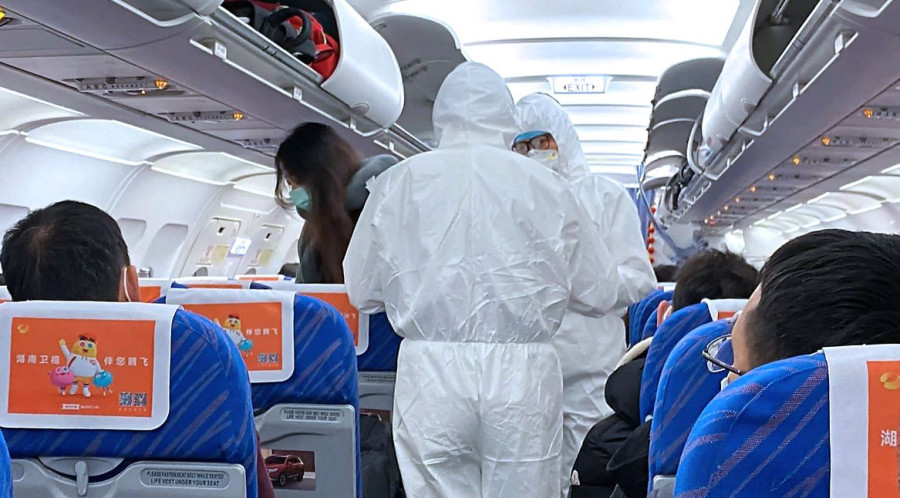National
The government has said it will evacuate Nepalis from Hubei, but it has yet to make preparations
Health officials and pilots say that evacuation will be a complicated procedure that requires meticulous planning.
Sangam Prasain & Arjun Poudel
A week since Nepalis in China's Hubei province asked the Nepal government to evacuate them, officials in Kathmandu have little idea how the evacuation will progress.
Last Sunday, the Nepali Embassy in Beijing said that it had received requests for evacuation from 180 Nepalis in Hubei, mostly from Wuhan, the epicentre of the novel coronavirus. The government subsequently pledged to bring the Nepalis back home but in the absence of concrete action, Nepalis in Hubei are getting desperate, especially after seeing numerous other countries, including India, evacuate their citizens.
"We don't know when exactly the government is planning to rescue Nepalis from Wuhan," Sagar Dahal, deputy spokesperson for the Ministry of Health and Population, told the Post. "We have been preparing and other concerned agencies are also doing their best."
Health experts say that a medical evacuation, unlike political decisions, is not easy to pull off as Nepal is “not prepared at all”. Evacuation from a quarantine zone requires meticulous planning and all actions need to be well-choreographed, with a zero margin of error, according to multiple officials, including pilots, the Post spoke to.
An evacuation plan requires a number of critical moving parts to work in unison. A proper medically equipped aircraft needs to be arranged, with protective gear for pilots and crew. All those requiring rescue will need to be assembled in one place, while ensuring that they do not infect each other. Once in Kathmandu, they will need to be disinfected upon exiting the craft and then transported to a secure quarantine facility in ambulances equipped with isolation chambers.
“Have we worked on all these components?” said Dr Bhim Acharya, a former director at the Epidemiology and Disease Control Division. "We are not prepared for the kind of situation we are trying to deal with.”
Acharya said it was irresponsible for the government to not have done anything substantial despite announcing that it would evacuate Nepalis a week ago.
With the death toll rising—by Saturday 722 had died and 34,546 were infected, Nepalis in China are getting increasingly impatient and concerned, and their parents too are worried back home.
On Thursday, Pramila Devkota, a student in Wuhan, expressed her unhappiness at the government’s lethargy.
“Despite repeated request for evacuation from 180 Nepalese students in Hubei, the government of Nepal has not taken any serious steps in this regard. We appeal the intl. community to speak for us. @OHCHRAsia @MofaNepal @MohnaAnsari,” Devkota wrote on Twitter.
On Friday, Devkota told the Post via Facebook that the situation is precarious and Nepalis are worried.
“We are anxious and waiting for the government to act,” said Devkota.
Parents of Nepalis stuck in Hubei have formed a pressure group and said that they have been making the rounds at various ministries to request that the evacuation process be expedited.
"It appears that government agencies themselves do not know how long it will take to complete necessary preparations," Sohan Prasad Sharma, whose son Amit is currently in Wuhan, told the Post over the phone from Chitwan. "I am extremely worried about my son, but I doubt the government will rescue him and other Nepalis.”
Basanta Bahadur Bhandari, whose son Jeet Singh is also in Wuhan, said the bureaucratic procrastination “is quite frustrating”.
"We feel helpless. We cannot do anything except tell our children not to worry," said Bhandari. "We do not understand how many days it will take for the government to complete the necessary preparations."
The government has said it may use a Nepal Airlines aircraft to evacuate Nepalis from China, but officials at the national flag carrier said there has been no formal request yet.
“We haven’t received any formal instruction from the government, but we are preparing internally," said Captain Deepu Jwarchan, director of Nepal Airlines' operations department. “Based on the estimated number of people, the 274-seater Airbus A330 would be ideal for the evacuation."
A day before the flight, the pilots and cabin crew will need to go through a detailed briefing.
“All procedures need to be based on guidelines from the World Health Organization,” said Jwarchan. “All people—flight crew, the ground handling, customs and immigration staffers—need to be provided with personal protective equipment and training as well.”
Jwarchan said protective suits, shoes, gloves, masks, eyewear and headgear will be required for the crew and the support staff. The rescue team will also need engineers and doctors.
Flying to Wuhan would be voluntary because the crew cannot be forced to do so, according to Jwarchan. Given the sensitivity of the evacuation and the inherent risk, some flight crew members may choose not to inform their families about the mission. It may be difficult to get together a crew willing to fly to the epicentre of the outbreak, but since it’s a humanitarian issue, some are likely to respond positively, said Nepal Airlines officials.
According to Jwarchan, evacuated passengers will not be offered any meals on the flight.
“The flight attendants’ responsibility will be limited to opening the doors and conducting a safety demonstration,” he said.
The total flight hours are 9 hours 30 minutes—arrival from Wuhan to Kathmandu will take five hours.
In Wuhan, the Civil Aviation Administration of China, the aviation authority, will arrange for all necessary logistics. But after landing in Wuhan, which is being described as a ghost town, the wait for the pilots and cabin crew could be longer than expected. According to a report in the Hindu newspaper on the evacuation of Indian citizens, pilots had to wait for eight hours at Wuhan airport before they returned with Indians evacuees.
According to Jwarchan, one meeting has already been held with representatives from the Civil Aviation Authority of Nepal, the Home and Health ministries and the WHO.
“We have prepared a guideline that basically states everyone's roles and we will work according to this guideline,” said Jwarchan.
But flying the plane to Wuhan to carry out Nepalis is just one component of the evacuation.
Deo Chandra Lal Karna, spokesperson for Tribhuvan International Airport, said they are not aware of the [government’s] evacuation plan.
“We will have to prepare from scratch,” said Karna.
The airport will need to arrange for evacuees and the plane itself to be placed in isolation until they are all cleared by health officials, according to Karna.
The new strain of coronavirus, which has been dubbed 2019-nCoV, spreads from person to person in close proximity, similar to other respiratory illnesses, such as the flu. The virus can be contracted from droplets of bodily fluids—such as saliva or mucus—from an infected person that are dispersed in the air or on surfaces while coughing or sneezing.
Transmission will be of particular concern during transport, as droplets containing the coronavirus could pass between passengers or via surfaces like plane seats and armrests.
Dr Hemanta Chandra Ojha, an official at the Epidemiology and Disease Control Division, said that his office still needs to provide necessary training to health workers before they are deployed to the quarantine facilities, which have yet to be built.
Apart from health workers, other people—ambulance drivers, bus drivers, and others—also need training, according to Ojha.
The incubation period of the coronavirus, the length of time before symptoms appear, is between one and 14 days. Those evacuated from Hubei will thus need to be placed in quarantine for at least 14 days.
Ojha conceded that the government's approach has been sluggish but said that several agencies—the Nepal Army, the Ministry of Home Affairs, Foreign Ministry, Health Ministry, Department of Immigration, Civil Aviation Authority—have been coordinating among themselves to complete necessary preparations.
Speaking at the Kantipur Conclave on Friday, Foreign Minister Pradeep Gyawali said that the government is concerned about Nepalis in China and that they will be back in Nepal “within a week”.
Bhim Acharya, former director of the epidemiology division, said that there has been a lot of talk but not much action.
"China built two hospitals in a matter of days to combat the new strain of coronavirus," Acharya told the Post. "But we have been unable to complete even basic preparations for a week. It is taking days just to finalise the location for the quarantine facilities.”
The government said it is planning to place the evacuees in isolation at the Bhaktapur-based training centre of the Nepal Army, a training hall of the Nepal Electricity Authority, an apartment built for squatters in Ichangu Narayan, and the Shivapuri barracks of the Nepal Army.
Nepal has so far had only one confirmed case of the coronavirus.




 6.73°C Kathmandu
6.73°C Kathmandu











%20(1).jpg&w=300&height=200)




